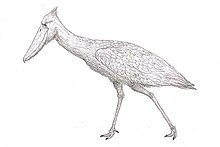Goliathia
Goliathia is an extinct genus of bird. The holotype is an ulna recovered from lower beds of the Jebel Qatrani Formation in Faiyum Governorate in Egypt. Initially thought to be a heron, an additional bone, a tarsometatarsus, showed this bird to be closely related to the living shoebill. Its full name is Goliathia andrewsii, but may be closely related enough to be classed within the same genus as the living species. The ancient habitat was likely a thickly vegetated freshwater swamp, with this species and a fossil jacana, as well as lungfish and catfish recovered from it. The same size as the living shoebill, it likely ate lungfish and catfish.[1]
| Goliathia | |
|---|---|
 | |
| Scientific classification | |
| Kingdom: | Animalia |
| Phylum: | Chordata |
| Class: | Aves |
| Order: | Pelecaniformes |
| Family: | Balaenicipitidae |
| Genus: | †Goliathia Lambrecht, 1930 |
| Species: | †G. andrewsii |
| Binomial name | |
| †Goliathia andrewsii Lambrecht, 1930 | |
Sources
- D. Tab Rasmussen; Storrs L. Olson; Elwyn L. Simons (1987). "Fossil Birds from the Oligocene Jebel Qatrani Formation, Fayum Province, Egypt" (PDF). Smithsonian Contributions to Paleobiology (62): 30–31. Retrieved 30 April 2012.
- The Origin and Evolution of Birds by Alan Feduccia, ISBN 978-0300078619
gollark: We have technological night vision goggles. Which are probably cheaper than genetically engineering people.
gollark: I do know about the various design flaws, but also we can compensate with technology.
gollark: I guess better eyes would be slightly useful.
gollark: Intelligence is very polygenic.
gollark: Maybe faster healing somehow, but good luck finding genes for that.
This article is issued from Wikipedia. The text is licensed under Creative Commons - Attribution - Sharealike. Additional terms may apply for the media files.